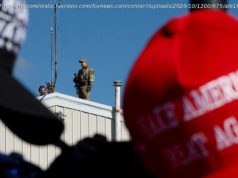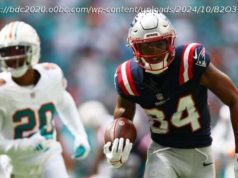How did your team fare in the first round of the draft? Our NFL Nation reporters analyze each top pick and how each fit their new team.
The 2019 NFL draft is finally here, and the Cardinals started it off selecting Oklahoma’s Kyler Murray, their second quarterback selected in the first-round in as many years. We’re tracking every pick for Rounds 1-7, and you can also see all of the best available prospects in the class.
NFL Nation reporters assess every first-round pick:
1. Arizona Cardinals
Kyler Murray, QB, Oklahoma| Highlights
Why they picked him: The Cardinals drafted Josh Rosen in the first round last season, so they don’t need a quarterback. But there was no way first-year coach Kliff Kingsbury was going to pass on Murray, who he has known since 2012 when he started recruiting him out of high school. The Heisman Trophy winner ran the Air Raid offense under coach Lincoln Riley at Oklahoma with success, and Murray will be running the same offense for Kingsbury in Arizona.
Biggest question: Can Murray be the same dynamic, playmaking, big-armed quarterback in the NFL he was in college? Murray’s skill level is not in question. What is in questions is whether the 5-foot-10 quarterback can run the Air Raid effectively when everyone else on the field is as or more athletic than what he faced at Oklahoma. Murray’s athleticism and ability to create plays was unmatched in college. But in the NFL, Murray’s injury risk is much greater, and the Cardinals can’t afford for the No. 1 overall pick to get hurt. — Josh Weinfuss
Weinfuss:Analysis for every Cardinals draft pick
2. San Francisco 49ers
Nick Bosa, DE, Ohio State| Highlights
Why they picked him: The 49ers added former Kansas City defensive end Dee Ford via trade but coach Kyle Shanahan is a firm believer that edge rusher is the most important position aside from quarterback. Over the past two seasons, the Niners have lost 11 one-possession games, buoying Shanahan and general manager John Lynch’s desire to add what Shanahan calls „closers,“ the type of players who can make that one big play to turn losses into wins in the fourth quarter. Bosa is widely regarded as that type of player and, given his brother Joey’s success in a similar defensive scheme with the Chargers, it’s not difficult for the Niners to envision Bosa teaming with Ford to form a tandem akin to Los Angeles‘ Joey Bosa and Melvin Ingram.
Biggest question: Can Bosa stay healthy and productive given the rigors of the NFL? Bosa played in just two-plus games before a bilateral core injury ended his junior season and college career. That injury came less than three years after he suffered a torn ACL in November 2015. — Nick Wagoner
Draft Academy:Watch Nick Bosa’s path to the NFL draft
3.New York Jets
Quinnen Williams, DT, Alabama| Highlights
Why they picked him: Looking to minimize risk, GM Mike Maccagnan – on the hot seat – takes the safest player in the draft. „No flaws,“ one AFC scout said of Williams, a disruptive force who produced a nation-leading 52 pressures among interior pass rushers. The Jets believe Williams, the 2018 Outland Trophy winner, is a potential „Gold Jacket“ player. He was a full-time contributor for only one season at Alabama, so he’s not even close to reaching his ceiling – and that’s scary. This is fifth time since 2011 the Jets have taken a defensive lineman in the first round.
Biggest question: Why not Kentucky OLB Josh Allen? He would’ve filled a big hole in the Jets‘ base 3-4 front, which lacks an edge-rushing linebacker. Another question: Where does Williams fit? He plays the 3- and 5-technique positions, which makes him similar to Leonard Williams and Henry Anderson. New defensive coordinator Gregg Williams can play multiple fronts, but it won’t be easy to get all three on the field at the same time. Leonard Williams is entering the final year of his contract; this could hurt his negotiating leverage. — Rich Cimini
4. Oakland Raiders
Clelin Ferrell, DE, Clemson| Highlights
Why they picked him: The Raiders, who had a league-low 13 sacks last season, need a pass-rushing defensive end in the worst way. Introducing the reigning Ted Hendricks Award winner from the national champions. Ferrell goes a tad higher than expected but he does address a need with 27 career sacks, 11.5 last season.
Biggest question: Surely Ferrell could have been taken later, so why didn’t the Raiders trade down and gather some more picks? At 6-foot-5,260 pounds with 4.8 speed in the 40, Ferrell is a specimen. But is he a Khalil Mack-type edge rusher? That’s what the Raiders are still missing. — Paul Gutierrez
5. Tampa Bay Buccaneers
Devin White, ILB, LSU| Highlights
Why they picked him: The Bucs needed a viable replacement at middle linebacker after losing Kwon Alexander and may have found themselves the next Patrick Willis. Like Alexander, White also served as a team captain at LSU. In fact, when the Bucs were interviewing White, they actually had Alexander’s picture on the wall. Like Alexander, White is a highly effective blitzer – perfect for Todd Bowles‘ scheme. He recorded the second-best pressure percentage among FBS players with at least 100 pass rushes in 2018, according to ESPN Stats and Information. He’s also demonstrated reliability in coverage.
Biggest question: The Bucs, who up until last year hadn’t had a player reach double-digit sacks in 12 seasons, passed on the draft’s best edge rusher in Josh Allen. Many would argue that Allen, who registered 17.0 sacks last year, could provide a more immediate impact. By passing on Ed Oliver, they also lost one of the best possible replacements for Gerald McCoy. As for White, there aren’t many weak spots, other than getting sucked up at times in play-action and needing to get better at diagnosing such plays. — Jenna Laine
6.New York Giants
Daniel Jones, QB, Duke| Highlights
Why they picked him: The Giants needed a future franchise quarterback. Manning is 38 years old and on the final year of his current contract. One coach who watched Jones‘ college tape thought he had a „fairly high ceiling“ and thought he checked all the boxes, especially behind the scenes and off the field. General manager Dave Gettleman recently said that was important for a quarterback stepping into Manning’s footsteps in New York. It also doesn’t hurt that Jones was trained by respected Duke coach David Cutcliff, who also worked with Eli and Peyton Manning in college.






